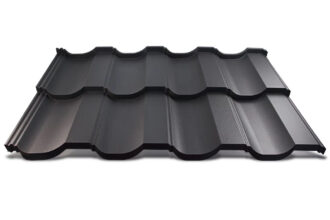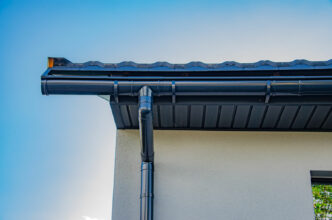When choosing the type of roof covering, it should be borne in mind that not every type of roof truss can be covered with every roofing material. The most important aspect in this context is the slope pitch. This is so because each type of roof covering has strict requirements when it comes to the roof pitch.
What roof truss is suitable for roof tiles?
Roof tiles provide a very aesthetic way of roof covering, but they cannot be used on flat roofs, or on those with a low pitch. Tiles can only be installed on steep roofs – those with a pitch of over 31°.
Therefore, the following roof trusses are suitable for roof tiles:
- typical purlin-tick truss – consisting of two types of trusses: main and intermediate, for roofs with a span of 9 m to 10 m and a pitch of over 31°,
- purlin-tick truss with a wooden knee wall – this type of structure is usually used in houses with an attic, and also in this case the pitch must exceed 31°.
What roof truss is suitable for metal roof tiles?
Metal roof tiles provide a covering with lower requirements than roof tiles. However, also in this case, in order to use this type of covering, the truss must meet certain conditions. Metal roof tiles cannot be used on flat roofs. If the roof is to be covered with steel sheet, it should be borne in mind that this material can be used on a roof with a pitch over 9°. Metal roof tiles with mineral or ceramic coating have greater requirements. In their case, the pitch must exceed 12°.
The following types of roof truss can be used for metal roof tiles:
- typical purlin-tick truss – only for roofs with a span of 9 m to 10 m and a pitch of over 9° (traditional metal roof tiles) or a pitch of over 12° (metal roof tiles with mineral or ceramic coating),
- purlin-tick truss with a wooden knee wall – usually used in houses with an attic, a pitch of over 9° (traditional metal roof tiles) or a pitch of over 12° (metal roof tiles with mineral or ceramic coating),
- flat purlin-tick roof – usually has one ridge purlin supported on queen posts, used for roofs with a span of up to 8-9 m, the permissible pitch from 6° to 18°, i.e., within the requirements for metal roof tiles,
- lattice truss – used in wooden skeleton houses and ever more frequently in concrete houses – for gable roofs with a slight pitch from 14° to 23°, but with an unusable attic – the pitch range falls within the requirements for metal roof tiles.
What roof truss is suitable for roof shingles?
In order for a roof to be covered with shingles, its pitch must be at least 15°. Therefore, the following types of truss are suitable for a shingle roof:
- typical purlin and tick truss (with a pitch of at least 15°),
- purlin-tick truss with a wooden knee wall (maintaining a pitch of at least 15°),
- flat purlin-tick roof (with a pitch of at least 15 °),
- lattice truss (also here, the pitch must be at least 15°).


